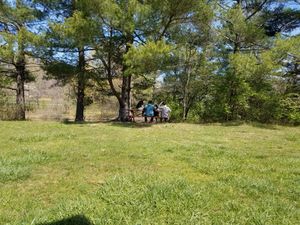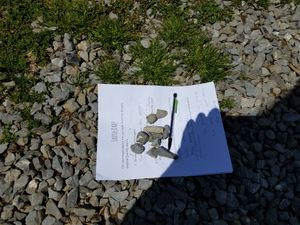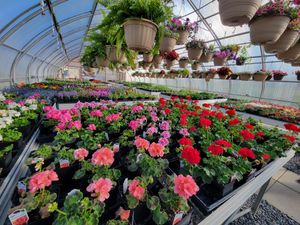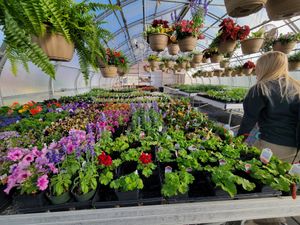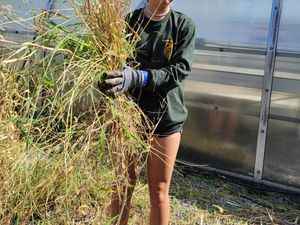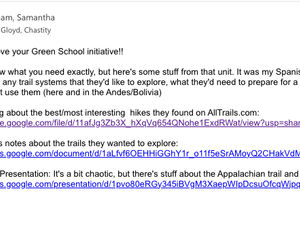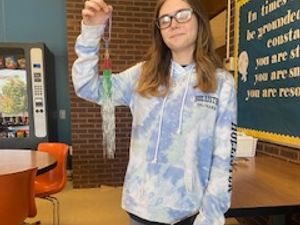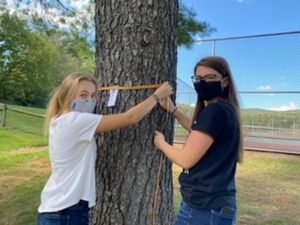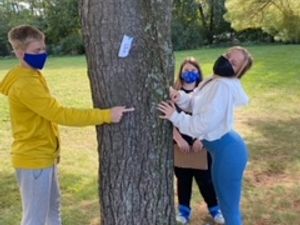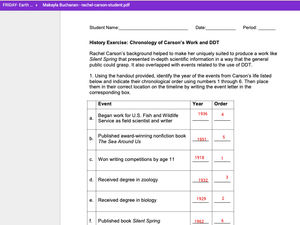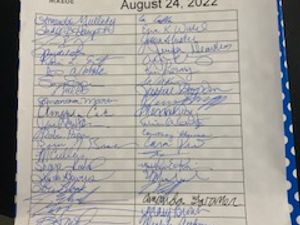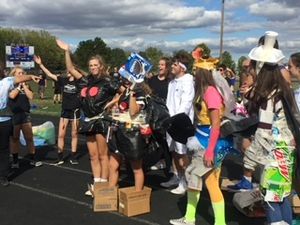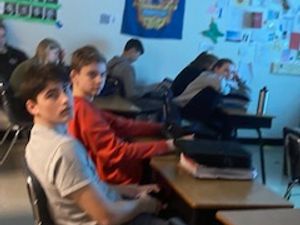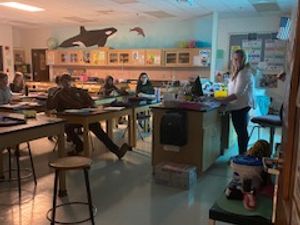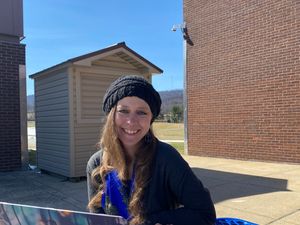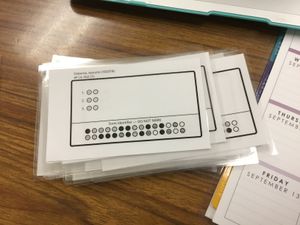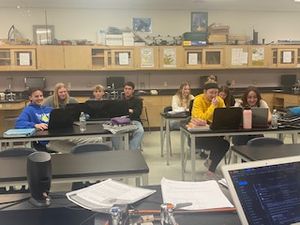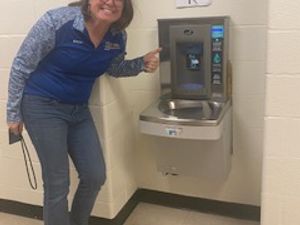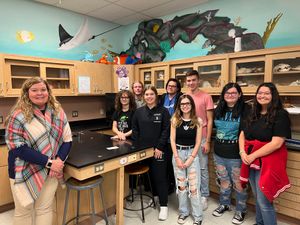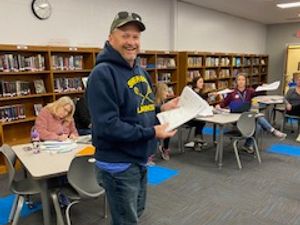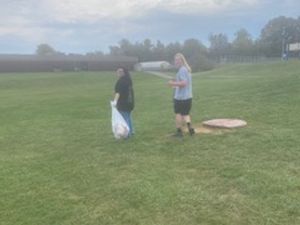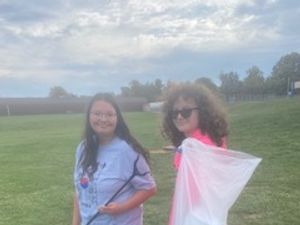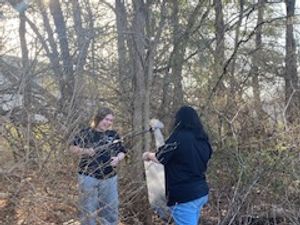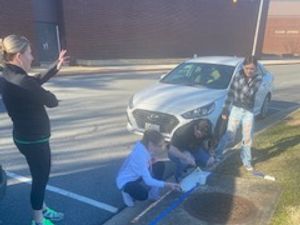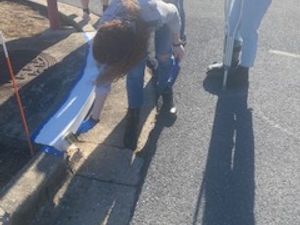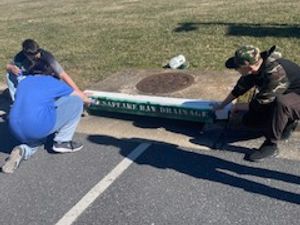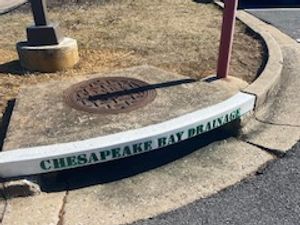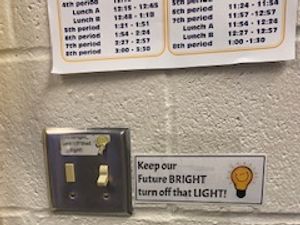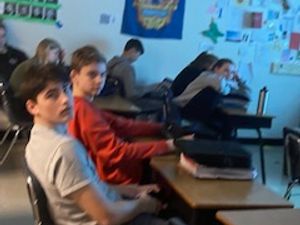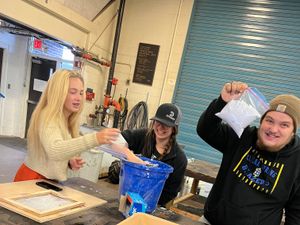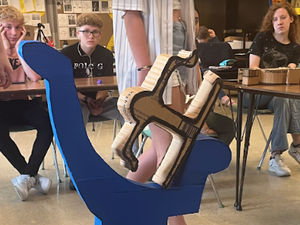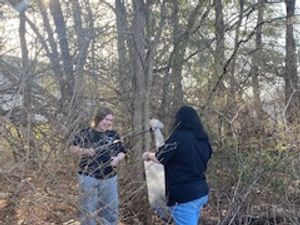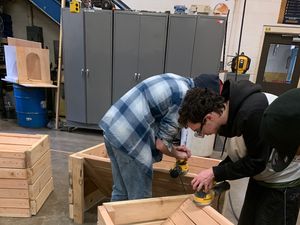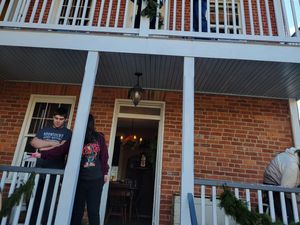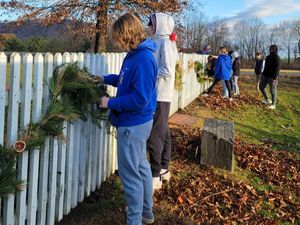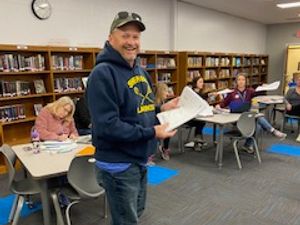Systemic Sustainability
Environmental Curriculum and Instruction
1.1 Curriculum and Instruction
Elementary & middle schools must provide one example of outdoor/environmental instruction per grade level.
High schools must provide one example of outdoor/environmental instruction in four subjects (which may include multiple different differents sciences).
Students collected water quality data from different locations from Big Pool using canoes.
We used gps on cell phones, so AGPS, to calculate the distances between various targets on campus. We’re then using some trigonometric formulas like Heron’s Area formula to calculate the areas of various triangular plats of land outside. This is to culminate a trig unit. The calculations that we’re doing are similar to what we do on the annual national Trig Star competition. Our precalc students all compete in this annual competition where there is guaranteed a school and county winner.
English classes walked to the pond and did a Nature/Literary Fusion lesson there.
Spanish IV & AP students studied the importance of national parks throughout the world. They researched activities that you can do in local national parks and created infographics on the various national parks of Spain. The unit ended with an AP test task where they had to speak for 2 minutes on the importance/relevance of national parks.
This was during COVID and students were at home. Students completed a Flipgrid as part of the assignment. Students are researching National Parks throughout the world to determine there importance and relevance.
This was during COVID. Teacher sent me copy of the lesson with links. Students are researching National Parks throughout the world to determine there importance and relevance
Students prepare plants to sell to the community, utilizing the school green house.
Students created a herb garden in the raised beds by the agriculture building. Horticulture students will practice food preservation of these herbs and vegetables.
Students in Spanish class, discovered and discussed trail systems that they'd like to explore, what they'd need to prepare for a hike, and what cultural significance the local trails might have to the people that use them (here and in the Andes/Bolivia)
Earth Day / Environmental Legislation This is the lesson that accompanies those photos. It was completed with my Honors US Studies II class, 9th grade, 22 students. Students learned about various environmental disasters to determine the reasons for the creation of the EPA and Earth Day. The images show the assessment where students did a sketch and tell of the environmental conditions before and after the creation of the EPA.
Students created a model using paper clips of bioaccumulation and biomagnification.
Students canoed on Big Pool and tested water samples to determine water quality. Students compared results to Potomac River water quality tests. Students also collected macro-invertebrates to determine water quality.
Students determining the carrying capacity of the trees on campus.
Students in Honors Chemistry read an article on Rachel Carson and her book Silent Spring. Students answered questions and completed a timeline of the events. Students learned about the bioaccumulation and biomagnification of DDT. The Lesson was completely digital and paperless for Earth Day.
1.2 Green School Awareness
1.2.1 School Wide Awareness - Staff
Demonstrate that all school personnel are aware of your school's Green School status and application process.
Staff were presented Green school application process each year 2019, 2021, 2022. It was not presented in 2020 due to COVID.
Staff were made aware that our Green School application is due to be resubmitted this school year. We brain stormed ideas as a committee of new things to do and expectations.
1.2.2 School-Wide Celebration
Demonstrate how your school celebrates beig a Green School by hosting a school-wide environmentally-focused event open to all students.
We held a school wide Pep Rally in 2019 in which students collected recycled material to make a designer dress. Each class had 5 minutes to assemble a dress.
In 2022 the CSHS participated in Earth Hour. Announcements were made and during 6th period lights were out across the school. Students were encouraged to also participate at home.
Students competed by class to make a dress out of recycled material they collected.
Staff and students school participated in Earth Hour during the last period of the day. Hallways, classrooms, the cafeteria, lights went out in order to conserve electricity and bring attention an education about Earth Hour to our staff and students.
Environmental Professional Development for Teachers
1.3.1 Environmental Professional Development for Teachers
Demonstrate that 10% of staff have completed an environmental PD. Instructional staff is defined as any staff that manages a gradebook.
- New Schools must have all PD completed within the past 2 academic years.
- Renewing schools must have all PD completed within the past 4 academic years.
A teacher who has participated in multiple workshops may only be counted once..
The Green leader Ed Waldron from the Claude Kitchen Outdoor school presented the school yard report card to staff.
Agriculture teachers Ms. Farmer and Ms. Michol participated in
The Green leader Ed Waldron from the Claude Kitchen Outdoor school presented the school yard report card to staff. Staff participated by completing the report card in teams.
2022 Maryland Ag Educators Conference. Teachers learned about shoreline restoration. The purpose of the tour was to show how important it is to maintain healthy streams by hardscaping and landscaping with the right materials. Attendees took seining nets into the stream to conduct analysis on water quality and identifying plant and animals. The group measured the effects of erosion by the natural tides and human factors. This tour greatly enhanced teacher knowledge on water quality, erosion control practices, habitat monitoring and establishing proper landscape to ensure healthy streams entering into a watershed.
1.4 Achieving Sustainable Schools
1.4.1 School-Wide Staff Sustainability
Demonstrate the sustainability practices your teachers, staff, and other personnel have implemented school-wide to make your school green. Any actions involving students belong under Objective 2.
Outdoor planning Ms. Melott has no windows in her classroom and chooses to complete her planning outside at a picnic table.
Ms. Kelly laminates her grade cam sheets to save paper and copies.
Our school system went to 1:1 Google Chromebooks during COVID. Teachers are using less paper and making less copies.
4 Water bottle filling stations were added to our school. Every fountain has a bottle filling station.
We have a Green Club that is student driven. These are the students that have completed many of the aspects of the Green School application. Green Club students have also started an Instagram for our Green club to highlight the many activities we are completing. We have a Green Club member that is our social media manager.
Ms. Melott utilizing her planning period outside
Laminated Grade Cam sheets
Laminated Grade Cam Sheets
Students using Google Chromebooks in the classroom
Mrs. Wadel was instrumental in getting the water bottle filling stations at our school.
The 2022-23 Green Club
Students using chromebooks in the classroom saves paper and copies.
The Green Club has an Instagram to highlight all the many activities we are are doing to keep our Green School status. The instagram is managed by a member of our Green Club.
1.4.2 Systemic Partnership
Demonstrate one partnership with a central office or board within the school system that supports part of the Maryland Green Schools Program. Any partnerships outside of your school system belong under Objective 3.
Ed Waldron is our Green Leader in Washington County, from the Claude Kitchens Outdoor School. He assists in answering questions about the Green School application. I called upon him to present a PD to my staff. He is someone I can always count on in this process.
Student Action
Schools must document eight total actions that address at least three of the listed sustainability practices.
These are student actions not adult actions. Adult sustainable actions can be documented in Objective 1.4.
2.1 Water Conservation/Pollution Prevention
2.1 Water Conservation/Pollution Prevention
Students picked up trash around the CSHS campus to prevent it from going into streams and rivers. We had 5 students participate and we picked up 20 lbs of trash.
10 students cleaned up 35 lbs of trash around the Clear Spring High School campus. These students are members of the Green Club.
Approximately 10 students from the Green Club gathered to pickup trash and located storm drains to stencil.
Green club students prepared storm drains for stenciling by painting the white background. We have 8 storm drains to prep and stencil. All students were invited to attend to help paint. We had about 15 students that participated. We had 3 teams of students painting storm drains.
Green club members stenciled storm drains with "Don't Dump Chesapeake Bay Drainage" stencils. Stencils were from the DNR storm drain stenciling program. Students worked in teams to stencil 8 storm drains on our campus.
2.2 Energy Conservation
2.2 Energy Conservation
Green Club students created signs, laminated them, and then taped them above every light switch in the school.
The entire school particapted in Earth Hour. Announcements were made to explain the purpose and describe the event. Then students and teachers participated in lights off for 1 hour at the end of the school day.
2.3 Solid Waste Reduction
2.3 Solid Waste Reduction
Students in Forestry and Soils class made recycled paper.
Recycled cardboard sculpture project based upon Keith Haring.
Students in AP Psychology used recycled materials to build a neuron. Then students used stop motion animation to explain action potential.
2.4 Habitat Restoration
2.4 Habitat Restoration
Green club students picked up trash from the school yard. Students collected 28 lbs of trash.
Students in Horticulture Science collect soil samples from the campus farm after the soybean were harvested.
Horticulture students will practice food preservation of these herbs and vegetables.
The Clear Spring High School Forestry students completed a service project for the Maryland Department of Natural Resources. Students collected black walnuts that will be used by DNR to plant along creeks, rivers, and streams, as part of the state's tree planting program. The program is aimed at enhancing habitat and water quality throughout the Chesapeake Bay Watershed.
2.6 Responsible Transportation
2.6 Responsible Transportation
No records were added by the school.
2.7 Healthy Indoor Environments
2.7 Healthy Indoor Environments
No records were added by the school.
2.8 Citzen/Community/Participatory Science
2.8 Citizen/Community/Participatory Science
No records were added by the school.
Community Partnership
Demonstrate that your school is forming long-term partnerships to foster environmental stewardship and cultivate community wellness through real-world connections.
3.1 Community Partnerships
3.1.1 School Active in Community
Describe at least one environmentally-focused partnership in which your school is working to benefit your community.
Agriculture students made 6 wheelchair accessible gardens to be used by the residents of the Western Maryland Hospital Center in Hagerstown. 30 students were involved
Benches made for the outdoor school. Students assisted in adding additional seating for students who attend the outdoor school. 4 sections of bench in the one pavilion, about 50 students helped with it.
3.1.2 Community Active in the School
Describe at least one partnership in which a community partner is benefitting the school. These actions and projects occur on or near school grounds with support from the partner.
Christy Hixon giving Floral Design students a tour of the historical Plumb Grove Mansion located near our campus and in our community.
Students made and decorated with Williamsburg style Christmas decor. Students used pine branches and dried fruit to make the decorations for Plumb Grove.
Ed Waldron is a Green Leader at Claude Kitchens outdoor school. Ed is my go to for everything Green School related. He helps with PD and checks my application. He is there when I have question.
3.2 Additional Achievements
3.2 Additional Achievements optional
Share any environmentally-related awards, special recognition, certifications, or other achievements that your school, staff or students have accomplished.
No records were added by the school.







